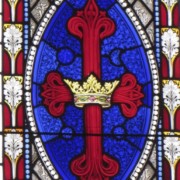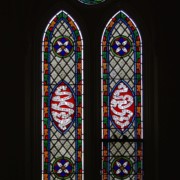
At the center of the lancets, in an oval medallion with a bright blue background, is a red cross with a gold crown, symbolizing Jesus’ Crucifixion and Resurrection as King of Heaven. The red-ground medallions radiating from it represent the ways the benefits of Christianity are communicated:

The large compound window behind the altar describes fundamental Episcopal beliefs in three parallel tall windows with pointed tops (lancets) below and three smaller, lobed panels above.

Many of these windows are done in grisaille, a technique whose name comes from the French word for gray, gris. Look closely at the grayish background, and you’ll see that it is composed of small diamond-shaped panes, each hand-painted in the same design using black, gray, or occasionally white enamel on frosted white glass.

Set into the grisaille are often medallions in bright blue, red, and other colors, decorated not with scenes of Biblical stories as in many churches, but with symbols of religious significance and with words—often quotations from the Bible. This style of window was commonly employed in English parish churches of the thirteenth century. Since Grace Church’s architecture imitates churches like these, the windows appropriately complement the building. Grisaille serves to screen out some of the outdoor light, but not as much as the deeply colored glass popular in earlier Gothic architecture, particularly in France.












































